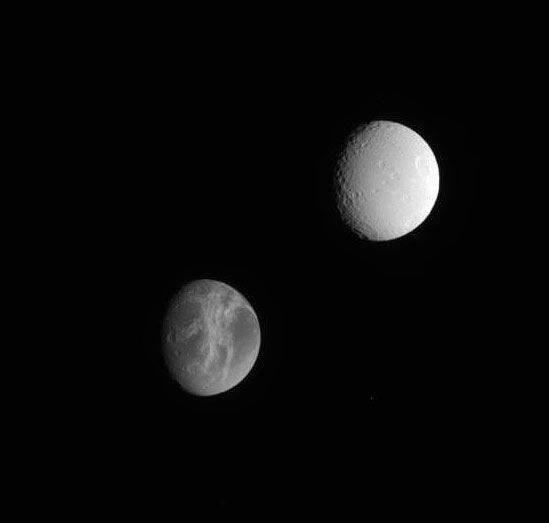Scientists looking at the various Lagrangian Points in our solar system noticed a pattern. Lagrange points, (named after their discoverer Josef Lagrange) are five special locations in the vicinity of two orbiting masses where a third, smaller mass can orbit at a fixed distance from the larger masses. Essentially, the gravity from each large mass is equal at that point and the smaller object can be “trapped” there. The 4th and 5th Largrange points, called L4 and L5, are stable points. Researchers Jack Lissauera, and John Chambers noticed that more than 2200 cataloged asteroids are located about the L4 and L5 points of the Sun–Jupiter system, and five bodies have been discovered around the L4 point of the Sun–Neptune system. Small satellites have also been found librating about the L4 and L5 points of two of Saturn’s moons. However, no objects have been discovered around the Earth–Moon L4 and L5 points. Their research led them to believe that other small moons may once have existed in these points.
The triangular Lagrange points, L4 and L5, form equilateral triangles with the two massive bodies (here, the Earth and the moon) and objects near L4 and L5 can remain close to these locations indefinitely.
Lissauera and Chambers say that using numerical integrations, they’ve shown that orbits near the Earth–Moon L4 and L5 points can survive for over a billion years even when the sun’s gravity is thrown into the mix. However, when the small perturbations from the other planets are present, that can destabilize the orbits at L4 and L5 within several million years. So, they deduced that even though there’s no objects at those points right now, that doesn’t mean there wasn’t something there in the past.
The leading candidate for the theory of the moon’s formation is that a Mars-sized object hit the Earth and the resulting debris formed the moon. The two researchers say other debris would have been present as well, and may have been trapped at the L4 and L5 points.
However, one has to wonder, with the moon, as well as Earth, in a state of flux following the collision, their gravitational fields may have been unstable enough to preclude any L points at the stage where the other debris or moons were in the area. Also, the moon used to be closer to Earth, and the L points would have changed over time, and this change also might have been enough to disengage any “trapped” moons.
But it’s interesting to consider the night sky with multiple moons.
Original News Sources: Icarus, New Scientist


Some computer models of the Big Whack showed that we had two moons created. They collided and much of their core dropped into the Earth, adding to our own core. We have lost several planets in the solar system. A planet the size of Mars colliding with the Earth after all created the Moon. Something caused chaos in the Uranus system. It seems reasonable that we did have two moons. Earth may even have Trojan asteroids in its orbit. Moons share the same orbit around Saturn. Pluto had a Big Whack and got three moons. The orbits are different, but it makes sense.
Hmm.. Not sure if I can subscribe to the idea, but…..
I recall some time ago of reading about a couple of rocks sharing earth’s orbit.. Maybe it was a fictional story, I don’t remember.. Anybody have any enlightenment?
@Al Hall
One of those is 3753 Cruithne, a near-Earth asteroid in a ‘horseshoe orbit’ with the Earth. It’s sometimes called Earth’s second moon, but that’s a bit of a stretch, really. 🙂
I too remember reading and seeing videos of computer models of the big whack, that created a second moon.
This second moon, according to the models, would not have lasted too long, and eventually would have crashed back into the Earth.
I don’t know how this could possibly be verified, so who knows.
@Al Hall
Cruithne is the best and longest known since the 80’s. And it’s orbit is weird. There are a couple others all discovered in the last half dozen years that I know of.
You may find a bit more here … there was even a false moon discovered about the same time.
http://mangsbatpage.433rd.com/2008/02/earths-other-moons.html
i was around at the time. i can verify that we had, in fact, 2 and a half moons. Luna, Filet, and Mignon.
Gee, maybe the planet Basidium really does exist, and Tyco Bass is planning his next trip to visit his fellow mushroom folk, the Mycetians…..
could the earths second moon have fallen and been the astroid that killed the dinosours or the one that caused the big crator in mexico
Is it possible that Pluto, Cedna, Eris or the other plutoids are the second moon of Earth?
Maybe knocked out of orbit by a passing star or even planet X, gravitationally captured in their current positions by the gas giants? Hell, even Mercury could be the second moon. BTW, im not convinced planet X/ Nibiru is all that true, but it sounds scary and something must of happened for the older civilizations to want to record it. I think all ancient txt is open to interpretation as their meanings for words could be different to ours and we all know the result of the game chinese whispers.